Bacterial cells are between 0.3 and 5 um in size. They have three basic
forms: cocci, straight rods, and curved or spiral rods. The nucleoid consists
of a very thin, long, circular DNA molecular double strand that is not surrounded
by a membrane. Among the nonessential genetic structures are
the plasmids. The cytoplasmic membrane harbors numerous proteins
such as permeases, cell wall synthesis enzymes, sensor proteins, secretion
system proteins, and, in aerobic bacteria, respiratory chain enzymes. The
membrane is surrounded by the cell wall, the most important element of
which is the supporting murein skeleton. The cell wall of Gram-negative bacteria
features a porous outer membrane into the outer surface of which the
lipopolysaccharide responsible for the pathogenesis of Gram-negative infections
is integrated. The cell wall of Gram-positive bacteria does not possess
such an outer membrane. Its murein layer is thicker and contains teichoic
acids and wall-associated proteins that contribute to the pathogenic process
in Gram-positive infections. Many bacteria have capsules made of polysaccharides
that protect them from phagocytosis. Attachment pili or fimbriae
facilitate adhesion to host cells. Motile bacteria possess flagella. Foreign body
infections are caused by bacteria that form a biofilm on inert surfaces. Some
bacteria produce spores, dormant forms that are highly resistant to chemical
and physical noxae.
forms: cocci, straight rods, and curved or spiral rods. The nucleoid consists
of a very thin, long, circular DNA molecular double strand that is not surrounded
by a membrane. Among the nonessential genetic structures are
the plasmids. The cytoplasmic membrane harbors numerous proteins
such as permeases, cell wall synthesis enzymes, sensor proteins, secretion
system proteins, and, in aerobic bacteria, respiratory chain enzymes. The
membrane is surrounded by the cell wall, the most important element of
which is the supporting murein skeleton. The cell wall of Gram-negative bacteria
features a porous outer membrane into the outer surface of which the
lipopolysaccharide responsible for the pathogenesis of Gram-negative infections
is integrated. The cell wall of Gram-positive bacteria does not possess
such an outer membrane. Its murein layer is thicker and contains teichoic
acids and wall-associated proteins that contribute to the pathogenic process
in Gram-positive infections. Many bacteria have capsules made of polysaccharides
that protect them from phagocytosis. Attachment pili or fimbriae
facilitate adhesion to host cells. Motile bacteria possess flagella. Foreign body
infections are caused by bacteria that form a biofilm on inert surfaces. Some
bacteria produce spores, dormant forms that are highly resistant to chemical
and physical noxae.

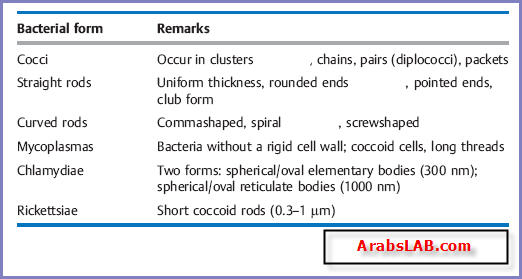
Morphological Characteristics of Bacteria
- Simple staining. In this technique, a single staining substance, e.g.,methylene blue, is used.
- Differential staining.Two stains with differing affinities to different bacteria
are used in differential staining techniques, the most important of which
is gram staining. Gram-positive bacteria stain blue-violet, Gram-negative
bacteria stain red.
Three basic forms are observed in bacteria: spherical, straight rods, and
curved rods.
Fine Structures of Bacteria
- Nucleoid (Nucleus Equivalent) and Plasmids
The "cellular nucleus" in prokaryotes consists of a tangle of double-stranded
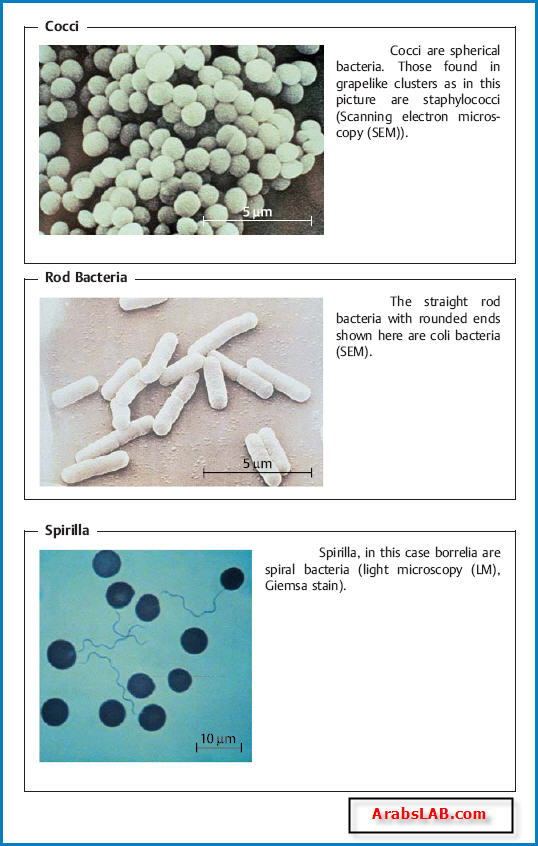
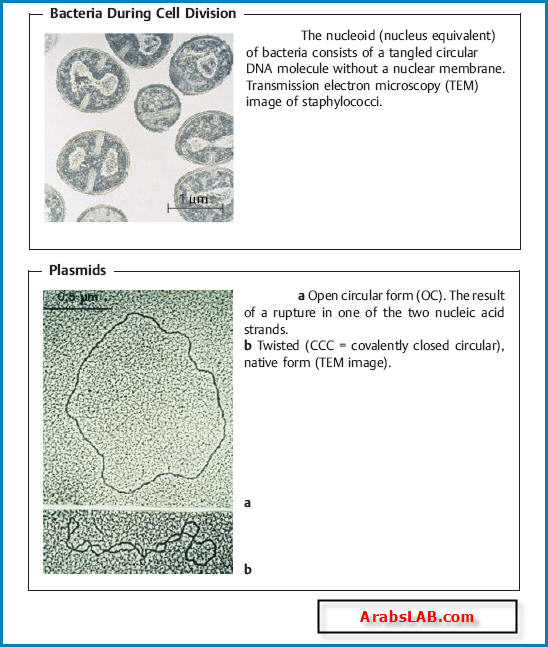
DNA, not surrounded by a membrane and localized in the cytoplasm .
In E. coli (and probably in all bacteria), it takes the form of a single circular
molecule of DNA. The genome of E. coli comprises 4.63 !106 base pairs (bp)
that code for 4288 different proteins. The genomic sequence of many bacteria
is known.
The plasmids are nonessential genetic structures. These circular, twisted
DNA molecules are 100–1000! smaller than the nucleoid genome structure
and reproduce autonomously. The plasmids of human pathogen
bacteria often bear important genes determining the phenotype of their cells
(resistance genes, virulence genes).
In E. coli (and probably in all bacteria), it takes the form of a single circular
molecule of DNA. The genome of E. coli comprises 4.63 !106 base pairs (bp)
that code for 4288 different proteins. The genomic sequence of many bacteria
is known.
The plasmids are nonessential genetic structures. These circular, twisted
DNA molecules are 100–1000! smaller than the nucleoid genome structure
and reproduce autonomously. The plasmids of human pathogen
bacteria often bear important genes determining the phenotype of their cells
(resistance genes, virulence genes).


- Cytoplasm
The cytoplasm contains a large number of solute low- and high-molecularweight substances, RNA and approximately 20 000 ribosomes per cell. Bacteria have 70S ribosomes comprising 30S and 50S subunits. Bacterial ribosomes function as the organelles for protein synthesis. The cytoplasm is also frequently used to store reserve substances (glycogen depots, polymerized ****phosphates, lipids).
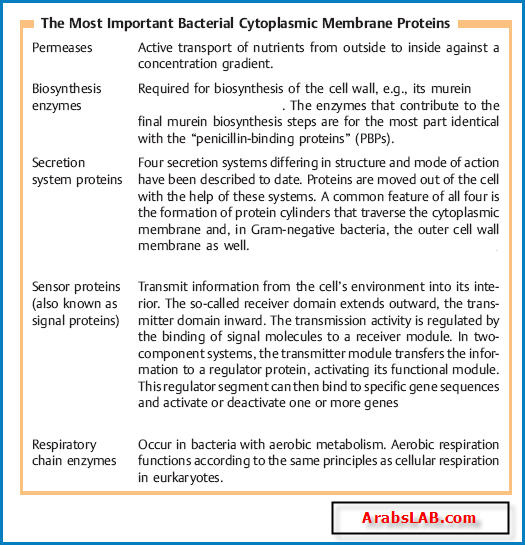
- The Cytoplasmic Membrane
This elementary membrane, also known as the plasma membrane, is typical
of living cells. It is basically a double layer of phospholipids with numerous
proteins integrated into its structure. The most important of these membrane
proteins are permeases, enzymes for the biosynthesis of the cellwall, transfer
proteins for secretion of extracellular proteins, sensor or signal proteins, and
respiratory chain enzymes.
In electron microscopic images of Gram-positive bacteria, the mesosomes
appear as structures bound to the membrane. How they function and what
role they play remain to be clarified. They may be no more than artifacts.
of living cells. It is basically a double layer of phospholipids with numerous
proteins integrated into its structure. The most important of these membrane
proteins are permeases, enzymes for the biosynthesis of the cellwall, transfer
proteins for secretion of extracellular proteins, sensor or signal proteins, and
respiratory chain enzymes.
In electron microscopic images of Gram-positive bacteria, the mesosomes
appear as structures bound to the membrane. How they function and what
role they play remain to be clarified. They may be no more than artifacts.
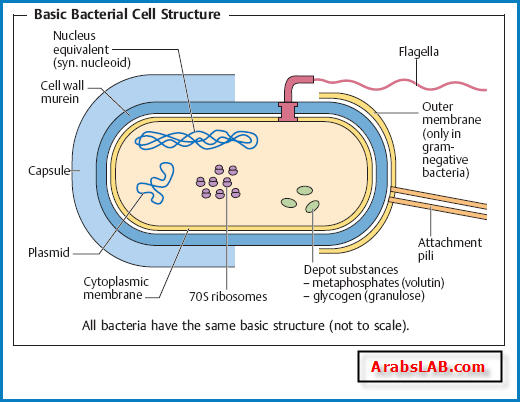

0 التعليقات:
Post a Comment